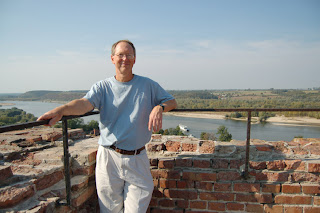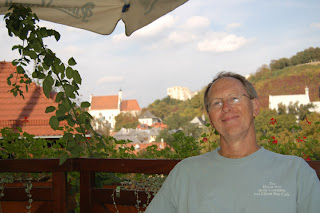
. . . and standing beside the photo of Marie Curie-Sklodowska (as she is known here).

We prevailed on a passing student to take our picture by the statue. This might be our favorite portrait of the trip.

En route to the university we passed their tennis courts—indoor (sheltered by a plastic bubble), and red clay!
After the university business was finished—and Poland is still the land of bureaucracy--we took advantage of the late afternoon light to take some pictures of the pedestrian street and Old Town in Lublin. Gary has to have a physical, get enrolled into the Polish equivalent of the IRS, etc. He plans to pay union dues to get his Solidarity card—maybe they have a T-shirt?
As is the case in Warsaw, the street leading away from the Old Town is called Krakowskie Przedmiescie or Krakow suburbs, and in Lublin it’s lined with banks, fashion shops, and (especially) beer and coffee stands. It’s a good place to stroll in the evening.

The entrance to the Old Town proper is the Krakow gate, the base of which dates from the 13th century.

A little before the gate is a church, which (as many do) posts funeral notices, pieces of paper with thick black borders.

The main square in the Old Town is not open as is the case in Warsaw, but has a court building in the middle. Nonetheless, you can find brightly colored, recently renovated buildings, some of which have pubs and clubs and restaurants, next to buildings in bad need of renovation. To the right is the Jewish restaurant where we ate dinner Wed. night, one of the best meals we’ve had on the trip.

This view shows the Lublin cathedral spire.

This passage is the narrowest in Lublin, perhaps the narrowest in Poland. The picture shows the typical cobblestone streets.

The castle exterior was built in mid-19th-c. because of the wall’s disrepair. However, the castle itself is medieval, with splendid Byzantine mozaics inside. During the war the Gestapo took over the castle as its headquarters.


Two views of the plaza in front of the castle.


On our way back to the Old Town and the Mandragora Restaurant, we stopped by the ruins of St. Michael’s church to take note of the moon, two or three days short of full. A good place to leave our travels for the time being. Thursday we leave for Warsaw, Friday morning Wendy leaves for the US, and Gary starts his work at UMCS in Lublin.

Another view of the front.









































